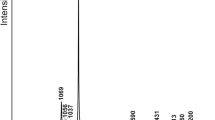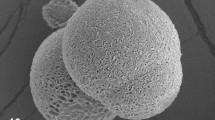Abstract
The paper reports a crystal chemical investigation of a haüyne sample, \( ({\rm Na}_{4.4}{\rm K}_{1.1}{\rm Ca}_{2.1}) _{\Sigma_{7.6}} [{\rm Si}_6{\rm Al}_6{\rm O}_{24}]\)(SO4)1.6(S3)0.3(CO2)0.1, from Sacrofano, Italy, conciliating spectroscopic, chemical, and room temperature (RT) X-ray single-crystal diffraction data. The RT structure refinement provides a detailed description of the extra-framework cations and anionic groups mutual arrangement. The occurrence of minor amounts of the S3 − poly-sulphur radical, responsible of the light-blue colour of the sample, revealed by Raman spectroscopy, has been shown to play an important role in modifying the cation partition among the three sites: M1, M2, and M3. Moreover, traces of enclathrated CO2 were revealed by FTIR. Besides, the thermal behaviour has been investigated, up to 1,098 K, by in situ HT-XRPD. Results indicate relevant differences with respect to reference data. The sample at RT shows weak satellite reflections that disappear at 673 K. As expected, the geometry of the rigid TO4 tetrahedra is independent from temperature, whereas the framework expands by decreasing the angle of rotation of both the SiO4 (φSi) and AlO4 (φAl) tetrahedra as a function of temperature. The quadric dependence of both φSi and φAl from temperature ends at 973 K, in correspondence of angles of rotation of ca. 3°, indicating the attainment of a nearly full expansion of the framework. At temperatures exceeding such value, only weak tetrahedral expansion acts. As a result of such thermal expansion mechanism, the dependence of the a-parameter from temperature shows a change of regime at 973 K. Such thermal expansion model is similar, albeit non-identical, to that of several cancrinite–sodalite group minerals.












Similar content being viewed by others
References
Ariai J, Smith SRP (1981) The Raman spectrum and analysis of phonon modes in sodalite. J Phys C Solid State Phys 14:1193–1202
Ballirano P (2012) The thermal behaviour of liottite. Phys Chem Miner 39:115–121
Ballirano P, Bosi F (2012) Thermal behaviour of afghanite, an ABABACAC member of the cancrinite group. Am Miner 97:630–640
Ballirano P, Cametti G (2012) Dehydration dynamics and thermal stability of erionite-K: experimental evidence of the "internal ionic exchange" mechanism. Microporous Mesoporous Mater doi:10.1016/j.micromeso.2012.06.059
Ballirano P, Maras A (2005) Crystal chemical and structural characterization of an unusual CO3-bearing sodalite-group mineral. Eur J Miner 17:805–812
Ballirano P, Melis E (2007) Thermal behaviour of β-anhydrite CaSO4 to 1,263 K. Phys Chem Miner 34:699–704
Ballirano P, Melis E (2009) Thermal behaviour and kinetics of dehydration of gypsum in air from in situ real-time laboratory parallel-beam X-ray powder diffraction. Phys Chem Miner 36:391–402
Ballirano P, Maras A, Buseck PR (1996) Crystal chemistry and IR spectroscopy of Cl- and SO4- bearing cancrinite-like minerals. Am Miner 81:1003–1012
Ballirano P, Bonaccorsi E, Maras A, Merlino S (2000) The crystal structure of franzinite, the ten-layer mineral of the cancrinite group. Can Miner 38:657–668
Bellatreccia F, Della Ventura G, Piccinini M, Cavallo A, Brilli M (2009) H2O and CO2 in minerals of the haüyne-sodalite group: an FTIR spectroscopy study. Mineral Mag 73:399–413
Bolotina NB, Rastsvetaeva RK, Sapozhnikov AN, Kashaev AA (2003) Twin orthorhombic structure of haüyne from Sakrofano (Italy). Crystallogr Rep 48:914–918
Bonaccorsi E, Comodi P, Merlino S (1995) Thermal behaviour of davyne-group minerals. Phys Chem Miner 22:367–374
Bonaccorsi E, Ballirano P, Cámara F (2012) The crystal structure of sacrofanite, the 74 Å phase of the cancrinite-sodalite supergroup. Microporous Mesoporous Mater 147:318–326
Brese NE, O’Keeffe M (1991) Bond-valence parameters for solids. Acta Crystallogr B47:192–197
Bruker AXS (2009) Topas V4.2: general profile and structure analysis software for powder diffraction data. Bruker AXS, Karlsruhe, Germany
Caron A, Donohue J (1965) Bond lengths and thermal vibrations in orthorombic sulfur. Acta Crystallogr 18:562–565
Cheary RW, Coelho A (1992) A fundamental parameters approach to X-ray line-profile fitting. J Appl Crystallogr 25:109–121
Choi KS, Kanatzidis MG (2000) Sulfosalts with alkaline earth metals. Centrosymmetric vs acentric interplay in Ba3Sb4.66S10 and Ba2.62Pb1.38Sb4S10 based on the Ba/Pb/Sb ratio. Phases related to arsenosulfide minerals of the rathite group and the novel polysulfide Sr6Sb6S17. Inorg Chem 39:5655–5662
Cotton FA, Harmon JB, Hedges RM (1976) Calculation of the ground state electronic structure and electronic spectra of di- and trisulfide radical anions by the scattered wave-SCF-Xα method. J Am Chem Soc 98:1417–1424
Dann SE, Mead PJ, Weller MT (1996) Loewenstein’s rule extended to an aluminum rich framework. The structure of bicchulite, Ca8(Al2SiO6)4(OH)8, by MAS NMR and neutron diffraction. Inorg Chem 35:1427–1428
Danø M (1965) The crystal structure of tugtupite-a new mineral, Na8Al2Be2Si8O24 (Cl, S)2. Acta Crystallogr 20:812–816
Delhez R, de Keijser TH, Langford JI, Louër D, Mittemeijer EJ, Sonneveld EJ (1993) Crystal imperfection broadening and peak shape in the Rietveld method. In: Young RA (ed) The Rietveld method. Oxford University Press, Oxford, pp 132–166
Di Muro A, Bonaccorsi E, Principe C (2004) Complex colour and chemical zoning of sodalite-group phases in a haüynophyre lava from Mt. Vulture, Italy. Mineral Mag 68:591–614
Evsyunin VG, Sapozhnikov AN, Rastsvetaeva RK, Kashaev AA (1996) Crystal structure of the potassium-rich haüyne from Arissia (Italy). Crystallogr Rep 41:659–662
Fei Y (1995) Thermal expansion. In: Ahrens JA (ed) A handbook of physical constants, mineral physics and crystallography, AGU Reference Shelf. American Geophysical Union, Washington, DC 2:29–44
Hassan I, Buseck PR (1989) Cluster ordering and antiphase domain boundaries in hauyne. Can Miner 27:173–180
Hassan I, Grundy HD (1984) The crystal structures of sodalite-group minerals. Acta Crystallogr B40:6–13
Hassan I, Grundy HD (1985) The crystal structure of helvite group minerals, (Mn, Fe, Zn)8[Be6Si6O24]S2. Am Miner 70:186–192
Hassan I, Grundy HD (1989) The structure of nosean, ideally Na8[Al6Si6O24]SO4·H2O. Can Miner 27:165–172
Hassan I, Grundy HD (1991a) The crystal structure of haüyne at 293 and 153 K. Can Miner 29:123–130
Hassan I, Grundy HD (1991b) The crystal structure and thermal expansion of tugtupite. Can Miner 29:123–130
Hassan I, Antao SM, Parise JB (2004a) Sodalite: high-temperature structures obtained from synchrotron radiation and Rietveld refinements. Am Miner 89:359–364
Hassan I, Antao SM, Parise JB (2004b) Haüyne: phase transition and high-temperature structures obtained from synchrotron radiation and Rietveld refinements. Mineral Mag 68:499–513
Hassan I, Antao SM, Parise JB (2006) Cancrinite: crystal structure, phase transitions, and dehydration behaviour with temperature. Am Miner 91:1117–1124
Henderson CMB, Taylor D (1978) The thermal expansion of synthetic aluminate-sodalites. Phys Chem Miner 2:337–347
Hu X, Depmeier W (1992) Pitfalls in the X-ray structure determination of pseudo symmetric sodalities, and possibly zeolites. Z Kristallogr 201:99–111
Ito T, Sadanaga R (1966) On the polysynthetic structure of haüyne. In: Abstracts of the 7th IUCR congress and symposium on crystal growth, Moskow, A55
Järvinen M (1993) Application of symmetrized harmonics expansion to correction of the preferred orientation effect. J Appl Crystallogr 26:525–531
Löhn J, Schulz H (1968) Strukturverfeinerung am Gestörten Haüyn, (Na5K1Ca2)Al6Si6O24(SO4)1.5. Neues Jahrb Miner Abh 109:201–210
McMullan RK, Ghose S, Haga N, Schomaker V (1996) Sodalite, Na4Si3Al3O12Cl: structure and ionic mobility at high temperatures by neutron diffraction. Acta Crystallogr B52:616–627
Orlandi P, Meerschaut A, Palvadeau P, Merlino S (2002) Lead-antimony sulfosalts from Tuscany (Italy). V. Definition and crystal structure of moëloite, Pb6Sb6S14(S3), a new mineral from the Ceragiola marble quarry. Eur J Miner 14:599–606
Ostroumov M, Fritsch E, Faulques E, Chauvet O (2002) Etude spectrometrique de la lazurite du Pamir, Tajikistan. Can Miner 40:885–893
Saalfeeld H (1961) Strukturbesonderheiten des Hauyngitters. Z Kristallogr 115:132–140
Sabine TM, Hunter BA, Sabine WR, Ball CJ (1998) Analytical expressions for the transmission factor and peak shift in absorbing cylindrical specimens. J Appl Crystallogr 31:47–51
Sahl K (1980) Refinement of the crystal structure of bicchulite, Ca2(Al2SiO6)(OH)2. Z Kristallogr 152:13–21
Shannon RD (1976) Revised effective ionic radii and systematic studies of interatomic distances in halides and chalcogenides. Acta Crystallogr A32:751–767
Sheldrick GM (2008) SHELXL-97. Program for crystal structure determination. Institut für Anorganische Chemie, Göttingen
Sokolova VG, Rybakov VB, Pautov LA, Pushcharovskii DYu (1993) Structural changes in tsaregorodsevite. Dokl Akad Nauk SSSR 332:309–313
Taylor D (1967) The sodalite-group of minerals. Contrib Mineral Petrol 16:172–188
Taylor D (1968) The thermal expansion of the sodalite group of minerals. Mineral Mag 36:761–769
Tsuchiya N, Takéuchi Y (1985) Fine texture of haüyne having a modulated structure. Z Kristallogr 173:273–281
Young RA (1993) Introduction to the Rietveld method. In: Young RA (ed) the Rietveld method. Oxford University Press, Oxford, pp 1–38
Acknowledgments
The author is grateful to Sergio Lucchesi, in memory of whom the paper is dedicated, for his help in data acquisition, and to M.L. Frezzotti for technical assistance during Raman spectroscopy data acquisition. Raman microprobe facilities are financially supported by P.N.R.A., the Italian Organization for Scientific Research in Antarctica. Electron microprobe analysis was carried out exploiting the facilities of the CNR-IGAG with the support of Mr. Marcello Serracino.
Author information
Authors and Affiliations
Corresponding author
Additional information
Dedicated in Memory of Prof. S. Lucchesi (1958–2010).
Rights and permissions
About this article
Cite this article
Ballirano, P. Haüyne: mutual cations/anionic groups arrangement and thermal expansion mechanism. Phys Chem Minerals 39, 733–747 (2012). https://doi.org/10.1007/s00269-012-0527-7
Received:
Accepted:
Published:
Issue Date:
DOI: https://doi.org/10.1007/s00269-012-0527-7




